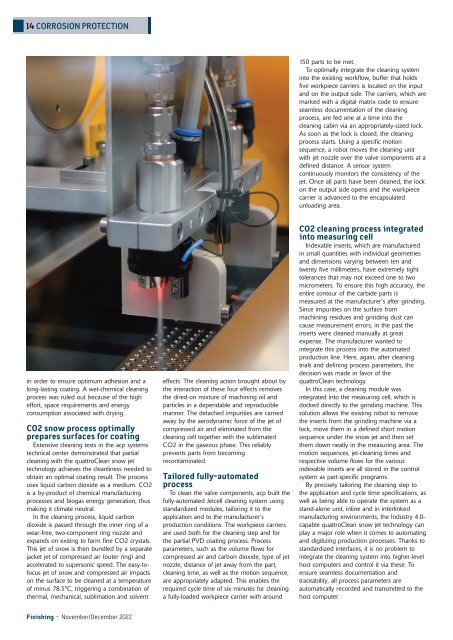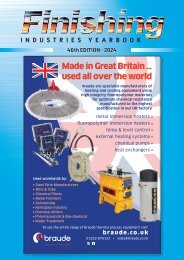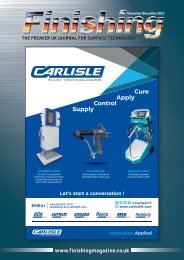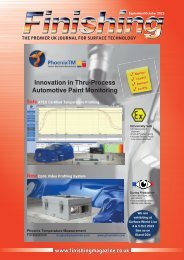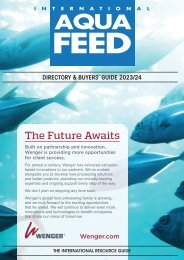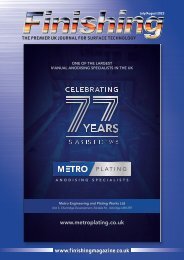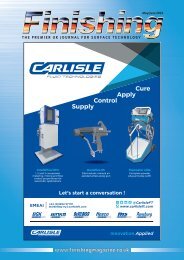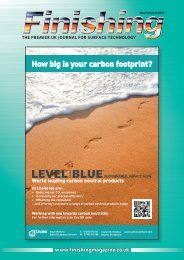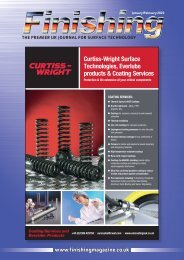Finishing - November-December 2022
It’s been difficult to keep up with the government at the moment, and hopefully by the time you read this we will have the same prime minister in position! The prime minister finally decided to go to COP 27 and it really does feel that governments around the world have to take climate change seriously. Investment in green infrastructure is vital to create a future for the generations to come and should be at the top of the agenda for any incoming government. Funny thing is, it’s not and maybe it won’t be until it’s too late. In the news we have investment from BASF in Germany and China. Let’s hope some of this comes to the UK. Also, there are the winners of the BCF Awards, plus news of some interesting projects from around the UK. Finally, I’d like to wish you all a merry Christmas and happy new year.
It’s been difficult to keep up with the government at the moment, and hopefully by the time you read this we will have the same prime minister in position!
The prime minister finally decided to go to COP 27 and it really does feel that governments around the world have to take climate change seriously. Investment in green infrastructure is vital to create a future for the generations to come and should be at the top of the agenda for any incoming government. Funny thing is, it’s not and maybe it won’t be until it’s too late.
In the news we have investment from BASF in Germany and China. Let’s hope some of this comes to the UK. Also, there are the winners of the BCF Awards, plus news of some interesting projects from around the UK. Finally, I’d like to wish you all a merry Christmas and happy new year.
You also want an ePaper? Increase the reach of your titles
YUMPU automatically turns print PDFs into web optimized ePapers that Google loves.
14 CORROSION PROTECTION<br />
150 parts to be met.<br />
To optimally integrate the cleaning system<br />
into the existing workflow, buffer that holds<br />
five workpiece carriers is located on the input<br />
and on the output side. The carriers, which are<br />
marked with a digital matrix code to ensure<br />
seamless documentation of the cleaning<br />
process, are fed one at a time into the<br />
cleaning cabin via an appropriately-sized lock.<br />
As soon as the lock is closed, the cleaning<br />
process starts. Using a specific motion<br />
sequence, a robot moves the cleaning unit<br />
with jet nozzle over the valve components at a<br />
defined distance. A sensor system<br />
continuously monitors the consistency of the<br />
jet. Once all parts have been cleaned, the lock<br />
on the output side opens and the workpiece<br />
carrier is advanced to the encapsulated<br />
unloading area.<br />
in order to ensure optimum adhesion and a<br />
long-lasting coating. A wet-chemical cleaning<br />
process was ruled out because of the high<br />
effort, space requirements and energy<br />
consumption associated with drying.<br />
CO2 snow process optimally<br />
prepares surfaces for coating<br />
Extensive cleaning tests in the acp systems<br />
technical center demonstrated that partial<br />
cleaning with the quattroClean snow jet<br />
technology achieves the cleanliness needed to<br />
obtain an optimal coating result. The process<br />
uses liquid carbon dioxide as a medium. CO2<br />
is a by-product of chemical manufacturing<br />
processes and biogas energy generation, thus<br />
making it climate neutral.<br />
In the cleaning process, liquid carbon<br />
dioxide is passed through the inner ring of a<br />
wear-free, two-component ring nozzle and<br />
expands on exiting to form fine CO2 crystals.<br />
This jet of snow is then bundled by a separate<br />
jacket jet of compressed air (outer ring) and<br />
accelerated to supersonic speed. The easy-tofocus<br />
jet of snow and compressed air impacts<br />
on the surface to be cleaned at a temperature<br />
of minus 78.5°C, triggering a combination of<br />
thermal, mechanical, sublimation and solvent<br />
effects. The cleaning action brought about by<br />
the interaction of these four effects removes<br />
the dried-on mixture of machining oil and<br />
particles in a dependable and reproducible<br />
manner. The detached impurities are carried<br />
away by the aerodynamic force of the jet of<br />
compressed air and eliminated from the<br />
cleaning cell together with the sublimated<br />
CO2 in the gaseous phase. This reliably<br />
prevents parts from becoming<br />
recontaminated.<br />
Tailored fully-automated<br />
process<br />
To clean the valve components, acp built the<br />
fully-automated Jetcell cleaning system using<br />
standardized modules, tailoring it to the<br />
application and to the manufacturer’s<br />
production conditions. The workpiece carriers<br />
are used both for the cleaning step and for<br />
the partial PVD coating process. Process<br />
parameters, such as the volume flows for<br />
compressed air and carbon dioxide, type of jet<br />
nozzle, distance of jet away from the part,<br />
cleaning time, as well as the motion sequence,<br />
are appropriately adapted. This enables the<br />
required cycle time of six minutes for cleaning<br />
a fully-loaded workpiece carrier with around<br />
CO2 cleaning process integrated<br />
into measuring cell<br />
Indexable inserts, which are manufactured<br />
in small quantities with individual geometries<br />
and dimensions varying between ten and<br />
twenty five millimeters, have extremely tight<br />
tolerances that may not exceed one to two<br />
micrometers. To ensure this high accuracy, the<br />
entire contour of the carbide parts is<br />
measured at the manufacturer's after grinding.<br />
Since impurities on the surface from<br />
machining residues and grinding dust can<br />
cause measurement errors, in the past the<br />
inserts were cleaned manually at great<br />
expense. The manufacturer wanted to<br />
integrate this process into the automated<br />
production line. Here, again, after cleaning<br />
trials and defining process parameters, the<br />
decision was made in favor of the<br />
quattroClean technology.<br />
In this case, a cleaning module was<br />
integrated into the measuring cell, which is<br />
docked directly to the grinding machine. This<br />
solution allows the existing robot to remove<br />
the inserts from the grinding machine via a<br />
lock, move them in a defined short motion<br />
sequence under the snow jet and then set<br />
them down neatly in the measuring area. The<br />
motion sequences, jet-cleaning times and<br />
respective volume flows for the various<br />
indexable inserts are all stored in the control<br />
system as part-specific programs.<br />
By precisely tailoring the cleaning step to<br />
the application and cycle time specifications, as<br />
well as being able to operate the system as a<br />
stand-alone unit, inline and in interlinked<br />
manufacturing environments, the Industry 4.0-<br />
capable quattroClean snow jet technology can<br />
play a major role when it comes to automating<br />
and digitizing production processes. Thanks to<br />
standardized interfaces, it is no problem to<br />
integrate the cleaning system into higher-level<br />
host computers and control it via these. To<br />
ensure seamless documentation and<br />
traceability, all process parameters are<br />
automatically recorded and transmitted to the<br />
host computer.<br />
<strong>Finishing</strong> - <strong>November</strong>/<strong>December</strong> <strong>2022</strong>


